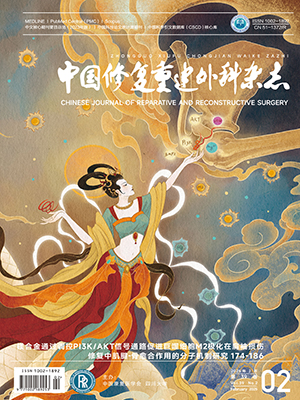| 1. |
Kong X, Gao J. Macrophage polarization: a key event in the secondary phase of acute spinal cord injury. J Cell Mol Med, 2017, 21(5): 941-954.
|
| 2. |
徐立, 梁军, 金涛, 等. 芒果苷对大鼠急性脊髓损伤的保护作用及相关机制研究. 中国修复重建外科杂志, 2016, 30(8): 1019-1925.
|
| 3. |
Guo L, Quan ZX, Zhao ZH, et al. Effects of musk ketone on nerve recovery after spinal cord injury. Genet Mol Res, 2015, 14(2): 2958-2963.
|
| 4. |
万峪岑, 孙师, 赵利娜, 等. 小剂量超短波治疗对大鼠脊髓损伤后炎症反应及水肿的影响. 中国康复理论与实践, 2016, 22(2): 150-155.
|
| 5. |
Zhang C, Ma J, Fan LH, et al. Neuroprotective effects of safranal in a rat model of traumatic injury to the spinal cord by anti-apoptotic, anti-inflammatory and edema-attenuating. Tissue Cell, 2015, 47(3): 291-300.
|
| 6. |
Liu CJ, Shi ZB, Fan LH, et al. Resveratrol improves neuron protection and functional recovery in rat model of spinal cord injury. Brain Res, 2011, 1374: 100-109.
|
| 7. |
Khanna S, Park H, Sen C et al. Neuroprotective and antiinflammatory properties of a novel demethylated curcuminoid. Antioxid Redox Signal, 2009, 11(3): 449-468.
|
| 8. |
Xie W, Yu YH, Du YP, et al. Saikosaponin a Enhances Transient Inactivating Potassium Current in Rat Hippocampal CA1 Neurons. Evid Based Complement Alternat Med, 2013, 2013: 413092.
|
| 9. |
Mao X, Miao GZ, Tao XG, et al. Saikosaponin a protects TBI rats after controlled cortical impact and the underlying mechanism. Am J Transl Res, 2016, 8(1): 133-141.
|
| 10. |
Hohlfeld R, Kerschensteiner M, Meinl E. Dual role of inflammation in CNS disease. Neurology, 2007, 68(Suppl 3): S58-S63.
|
| 11. |
王涛丽, 顾兵, 李华南, 等. 急性脊髓损伤后的炎症反应及其抗炎治疗. 中国药理学通报, 2015, 31(4): 452-457.
|
| 12. |
赵梦滢, 朱钰文, 黄立丹, 等. 肿瘤坏死因子-α 与脊髓损伤的研究进展. 神经损伤与功能重建, 2016, 11(2): 155-157.
|
| 13. |
Zhang X, Shi LL, Gao X, et al. Lentivirus-mediated inhibition of tumour necrosis factor-alpha improves motor function associated with PRDX6 in spinal cord contusion rats. Sci Rep, 2015, 5: 8486.
|
| 14. |
徐玉生, 张松, 金伟林, 等. 褪黑素对大鼠脊髓损伤后肿瘤坏死因子-a 表达的影响. 郑州大学学报(医学版), 2014, 49(1): 41-44.
|
| 15. |
Pishva1 AA, Akbari M, Farahabadi A, et al. Effect of estrogen therapy on TNF-α and iNOS gene expression in spinal cord injury model. Acta Med Iran, 2016, 54(5): 296-301.
|
| 16. |
Liu XH, Bauman WA, Cardozo C, ANKRD1 modulates inflammatory responses in C2C12 myoblasts through feedback inhibition of NF-kappaB signaling activity. Biochem Biophys Res Commun, 2015, 464(1): 208-213.
|
| 17. |
Yarar-Fisher C, Bickl CS, Kelly NA, et al. Heightened TWEAK-NF-kappaB signaling and inflammation-associated fibrosis in paralyzed muscles of men with chronic spinal cord injury. Am J Physiol Endocrinol Metab, 2016, 310(9): E754-761.
|
| 18. |
Bethea JR, Castro M, Keane RW, et al. Traumatic spinal cord injury induces nuclear factor-B activation. J Neurosci, 1998, 18(9): 3251-3260.
|
| 19. |
Brambilla R, Bracchi-Ricard V, Hu WH, et al. Inhibition of astroglial nuclear factor kappaB reduces inflammation and improves functional recovery after spinal cord injury. J Exp Med, 2005, 202(1): 145-156.
|
| 20. |
Oklinski MK, Skowronski M, Skowronska AT, et al. Aquaporins in the Spinal Cord. Int J Mol Sci, 2016, 17(12). pii: E2050.
|
| 21. |
Liu X, Wang Y, Yang J, et al. Anti-edema effect of melatonin on spinal cord injury in rats. Biomed Pap Med Fac Univ Palacky Olomouc Czech Repub, 2015, 159(2): 220-226.
|
| 22. |
Ito H, Yamamoto N, Arima H, et al. Interleukin-1beta induces the expression of aquaporin-4 through a nuclear factor-kappaB pathway in rat astrocytes. J Neurochem, 2006, 99(1): 107-118.
|
| 23. |
李野. AQP4 和 Kir4. 1 在急性脊髓损伤后脊髓水肿中的作用机制研究. 吉林: 吉林大学, 2015.
|




